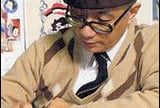Osamu was born, as the eldest son of three children of Tezuka family, on November 3, 1928, in Toyonaka City, Osaka. His nickname was gashagasha-atama (gashagasha is slang for messy, atama means head). His mother often comforted him by telling him to look to the blue skies, giving him confidence. His mother’s stories inspired his creativity as well. Tezuka grew up in Takarazuka City, Hyōgo and his mother often took him to the Takarazuka Theatre.
Osamu Tezuka
The Takarazuka Revue that performed at the theatre is made up in its entirety of women, and so male characters are also played by women. The Takarazuka Revue is known for its romantic musicals usually aimed at a female audience, thus having a large impact on the later works of Tezuka, including his costuming designs. He has said that he has a profound “spirit of nostalgia” for Takarazuka. His animation production company was named Mushi (insect) Production.
He started to draw comics around his second year of elementary school. Around his fifth year he found a bug named “Osamushi”. It so resembled his name that he adopted osamushi as his pen name. He came to the realization that he could use manga as a means of helping to convince people to care for the world. After World War II, he created his first piece of work (at age 17), Diary of Ma-chan and then Shin Takarajima (New Treasure Island), which began the golden age of manga, a craze comparable to American comic books at the time. Japanese manga artists call him “Manga-no-kami sama” [the god of manga].
Works & Style
Tezuka is known for his imaginative stories and stylized Japanese adaptations of western literature. He loved reading novels and watching films that came from the West. Tezuka’s early works included manga versions of Disney movies such as Bambi. His work, like that of other manga creators, was sometimes gritty and violent. However, he stayed away from graphic violence in some titles such as Astro Boy. The distinctive “large eyes” style of Japanese animation was invented by Tezuka, drawing inspirations on cartoons of the time such as Betty Boop and Walt Disney’s Bambi and Mickey Mouse. As an indication of his productivity, the Complete Manga Works of Tezuka Osamu comprises some 400 volumes, over 80,000 pages; even so, it is not comprehensive. His complete oeuvre includes over 700 manga with more than 150,000 pages. However, the vast majority of his work has never been translated from the original Japanese and is thus inaccessible to people who do not read Japanese.
When he was younger, Tezuka’s arms swelled up and he became ill. He was treated and cured by a doctor which made him want to be a doctor. However, he began his career as a manga artist while a university student, drawing his first professional work while at school. At a crossing point, he asked his mother whether he should look into doing manga full time or whether he should become a doctor. At the time, being a manga author was not a particularly rewarding job. The answer his mother gave was: “You should work doing the thing you like most of all.” Tezuka decided to devote himself to manga creation on a full-time basis. He graduated from Osaka University and obtained his medical degree, but he would later use his medical and scientific knowledge to enrich his sci-fi manga, such as Black Jack.
His creations include Astro Boy (Tetsuwan Atomu in Japan, literally translated to “Iron-armed Atom”), Black Jack, Princess Knight, Phoenix (Hi no Tori in Japan), Kimba the White Lion, Adolf and Buddha. His “life’s work” was Phoenix — a story of life and death that he began in the 1950s and continued until his death.
In January 1965, Tezuka received a letter from Stanley Kubrick, who had watched Astro Boy and wanted to invite Tezuka to be the art director of his next movie 2001: A Space Odyssey. Tezuka could not afford to leave his studio for an entire year to live in England, so he refused the invitation. Though he could not work on it, he loved the movie, and would play its soundtrack at maximum volume in his studio to keep him awake during the long nights of work.
Tezuka headed the animation production studio Mushi Production (“Bug Production”), which pioneered TV animation in Japan. The name of the studio derives from one of the kanji (虫 – Japanese reading: mushi, English meaning: bug,insect) used to write his name. Many young manga artists once lived in the apartment where Tezuka lived, Tokiwa-so. (As the suffix -so indicates, this was probably a small, inexpensive apartment.) The residents included Shotaro Ishinomori; Fujio Akatsuka; and Abiko Motou and Hiroshi Fujimoto (who worked together under the pen name Fujiko Fujio).
He was a personal friend (and apparent artistic influence) of Brazilian comic book artist Mauricio de Sousa.
Tezuka died of stomach cancer on February 9, 1989, at the age of 60. His death came about one month after the death of Hirohito, the Shōwa Emperor of Japan. In an afterword written by Takayuki Matsutani, president of Mushi Productions, that was published in Viz Media’s English language release of the Hi no Tori manga, it is said that his last words were, “I’m begging you, let me work!”
His legacy has continued to be honored among Manga artists and animators and many artists including Hayao Miyazaki (Spirited Away), Akira Toriyama (Dragon Ball), and Kazuki Takahashi (Yu-Gi-Oh!) have cited Tezuka an inspiration for their works.
Awards
1958 Shogakukan Manga Award for Manga Seminar on Biology and Biiko-chan
1975 Bungeishunjū manga Award
1975 Japan Mangaka Association Award — Special Award
1977 Kodansha Manga Award for Black Jack and The Three-Eyed One
1983 Shogakukan Manga Award for Hidamari no Ki
1984 Animafest Zagreb Grand Prize for Jumping
1985 Hiroshima International Animation Festival for Onboro-Film
1986 Kodansha Manga Award for Adolf
1989 Nihon SF Taisho Award – Special Award
1989 Zuihōsho 3rd class
2004 Eisner Award for Buddha (vols. 1–2)
2005 Eisner Award for Buddha (vols. 3–4)
2009 Eisner Award for Dororo
Source: Wikipedia



